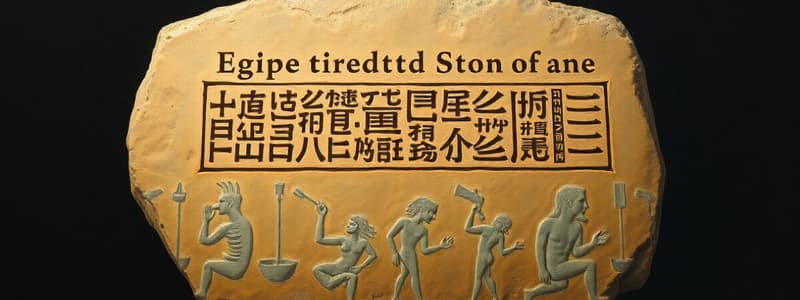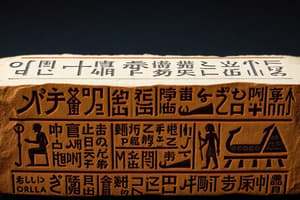Podcast
Questions and Answers
What was the primary purpose of the Rosetta Stone when it was originally created?
What was the primary purpose of the Rosetta Stone when it was originally created?
- To provide a learning tool for languages
- To document historical events of the time
- To announce the importance of the pharaoh's role (correct)
- To serve as a religious artifact
Which researcher first recognized the symbols that spelled the name 'Ptolemy' on the Rosetta Stone?
Which researcher first recognized the symbols that spelled the name 'Ptolemy' on the Rosetta Stone?
- Sir Isaac Newton
- Rudolf Roth
- Thomas Young (correct)
- Jean-François Champollion
Which of the following languages is NOT one of the three languages found on the Rosetta Stone?
Which of the following languages is NOT one of the three languages found on the Rosetta Stone?
- Demotic
- Hieroglyphics
- Latin (correct)
- Greek
What major accomplishment did Young and Champollion achieve in relation to the Rosetta Stone?
What major accomplishment did Young and Champollion achieve in relation to the Rosetta Stone?
What is the main uncertainty regarding the Rongorongo symbols found on Easter Island?
What is the main uncertainty regarding the Rongorongo symbols found on Easter Island?
What is the primary language of the Voynich Manuscript believed to be?
What is the primary language of the Voynich Manuscript believed to be?
Which two interpretations of the Voynich Manuscript have been suggested?
Which two interpretations of the Voynich Manuscript have been suggested?
What is the estimated age of the Tartaria Tablets based on current research?
What is the estimated age of the Tartaria Tablets based on current research?
What remains uncertain regarding the Tartaria Tablets?
What remains uncertain regarding the Tartaria Tablets?
What impact has the mystery surrounding the Voynich Manuscript had on popular culture?
What impact has the mystery surrounding the Voynich Manuscript had on popular culture?
Study Notes
The Rosetta Stone
- Located in the British Museum, the Rosetta Stone appears to be a mundane piece of rock but plays a pivotal role in the understanding of ancient history.
- The stone is actually a tax document, commemorating the rule of Pharaoh Ptolemy V, written in three languages: Greek, Demotic, and hieroglyphics.
- Created in 196 BCE, the Rosetta Stone was one of 18 stones installed in temples across Egypt to announce the pharaoh's significance and enact tax benefits for priests.
- After 2000 years in Egypt, the stone was captured by the British Army in 1801 and brought to London for academic study.
- Early attempts to decipher hieroglyphics were unsuccessful until Thomas Young identified symbols spelling "Ptolemy," later advanced by Jean-François Champollion, who decoded the text in 1822.
Mysteries of Unsolved Languages
- Several manuscripts remain undeciphered despite extensive research, including:
- Rongorongo: A potential written language found on wooden artifacts from Easter Island in the 19th century, consisting of symbols representing animals, humans, and plants. Its interpretation remains elusive, with theories linking it to lunar cycles or suggesting it may have been a memory aid or decorative art.
- Voynich Manuscript: Dated to the early 15th century, this book features an unknown language and bizarre illustrations of flora and fauna. Its contents have sparked debates about its authenticity, potential as a medieval medicinal guide, or even a hoax.
- Tartaria Tablets: Discovered in Romania in 1961, these discs are estimated to be over 7000 years old, possibly representing the earliest known form of writing. Their symbols and meanings remain a subject of contention among experts.
Ongoing Exploration of Ancient Messages
- Despite breakthroughs like those achieved with the Rosetta Stone, many historical scripts and symbols remain undeciphered, inspiring ongoing research and speculation.
- The enigmatic nature of these artifacts continues to spark interest in archaeology, linguistics, and cultural history, prompting future discoveries and interpretations.
Studying That Suits You
Use AI to generate personalized quizzes and flashcards to suit your learning preferences.
Description
Explore the significance of the Rosetta Stone, a crucial artifact for understanding ancient languages, particularly hieroglyphics. This quiz also delves into unsolved languages and manuscripts, highlighting the ongoing mysteries in linguistic research. Test your knowledge on the historical and linguistic context of this fascinating topic.




